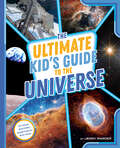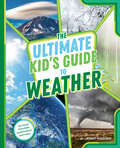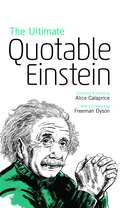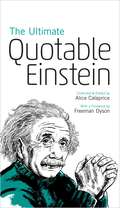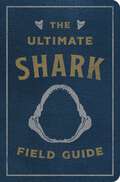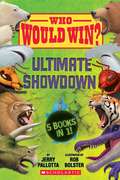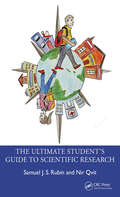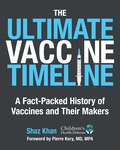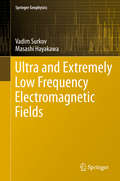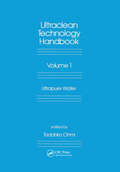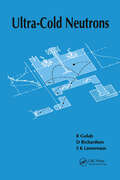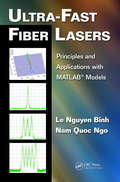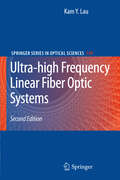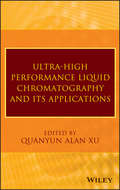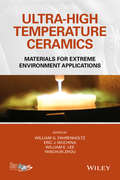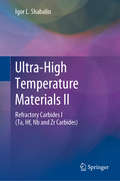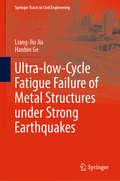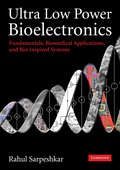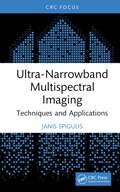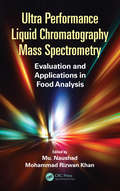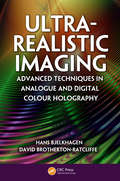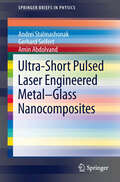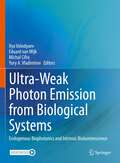- Table View
- List View
The Ultimate Kid's Guide to the Universe: At-Home Activities, Experiments, and More! (The Ultimate Kid's Guide to...)
by Jenny MarderWith stunning photos of outer space and easy at-home experiments, this is the only guide kids need on their journey of learning about all things astronomy: the stars, the planets, the moon, and so much more!Buckle up and let Jenny Marder, a senior writer for NASA, be your guide to the universe! First stop: the moon!A perfect read for kids, just in time for the April 2024 total solar eclipse!
The Ultimate Kid's Guide to Weather: At-Home Activities, Experiments, and More! (The Ultimate Kid's Guide to...)
by Jenny MarderWith stunning photos of Earth's wildest weather and easy at-home STEM activities, this is the only guide kids need on their journey of learning about all things meteorology.Buckle up and let Jenny Marder, a senior writer for NASA, be your guide through the Earth&’s atmosphere! First stop: the stratosphere!
The Ultimate Quotable Einstein
by Alice Calaprice Freeman Dyson Albert EinsteinHere is the definitive new edition of the hugely popular collection of Einstein quotations that has sold tens of thousands of copies worldwide and been translated into twenty-five languages. The Ultimate Quotable Einstein features 400 additional quotes, bringing the total to roughly 1,600 in all. This ultimate edition includes new sections--"On and to Children," "On Race and Prejudice," and "Einstein's Verses: A Small Selection"--as well as a chronology of Einstein's life and accomplishments, Freeman Dyson's authoritative foreword, and new commentary by Alice Calaprice. In The Ultimate Quotable Einstein, readers will also find quotes by others about Einstein along with quotes attributed to him. Every quotation in this informative and entertaining collection is fully documented, and Calaprice has carefully selected new photographs and cartoons to introduce each section.Features 400 additional quotations Contains roughly 1,600 quotations in all Includes new sections on children, race and prejudice, and Einstein's poetry Provides new commentary Beautifully illustrated The most comprehensive collection of Einstein quotes ever published
The Ultimate Quotable Einstein
by Albert EinsteinThis is the definitive edition of the hugely popular collection of Einstein quotations that has sold tens of thousands of copies worldwide and been translated into twenty-five languages.The Ultimate Quotable Einstein features roughly 1,600 quotes in all. This paperback edition includes sections unique to the ultimate collection--"On and to Children," "On Race and Prejudice," and "Einstein's Verses: A Small Selection"--as well as a chronology of Einstein’s life and accomplishments, Freeman Dyson’s authoritative foreword, and commentary and descriptive source notes by Alice Calaprice.
The Ultimate Shark Field Guide: The Ocean Explorer's Handbook (Sharks, Observations, Science, Nature, Field Guide, Marine Biology for Kids)
by Thomas NelsonSwim alongside your favorite underwater creatures with The Ultimate Shark Field Guide--created as if a marine biologist painted these illustrations and made these notes while out collecting research.Pick up the journal of a marine biologist and discover underwater mysteries with The Ultimate Shark Field Guide. Encounter sharks of all shapes and sizes and note observations on each species' appearance, size, diet, and more. Detailed watercolor illustrations will captivate young readers. This spectacular visual guide gets you up close and personal with some of the fiercest creatures on Earth, including the bull shark, the great white, the Ganges river shark, the whale shark, and the great hammerhead. Explore underwater landscapes with these incredible animals in The Ultimate Shark Field Guide!
Ultimate Showdown (Who Would Win?)
by Jerry Pallotta Robert BolsterWhat if one dangerous animal had a fight with another? Who do you think would win? In this five-book bind-up of the popular Who Would Win? series, kids will learn about each animal's anatomy, behavior, and more. Then compare and contrast the battling pairs before finally discovering the winner! This nonfiction collection is full of facts, photos, and realistic illustrations, and it includes a range of mammals, sea creatures, insects, and dinosaurs to satisfy all kinds of animal fans, including Lion vs. Tiger, Hammerhead vs. Bull Shark, Polar Bear vs. Grizzly Bear, Hornet vs. Wasp, and Triceratops vs. Spinosaurus. <p><p> So who do YOU think would win?
The Ultimate Student’s Guide to Scientific Research
by Samuel J. Rubin Nir QvitA scientific career is a long and winding journey. Many factors assemble to determine the trajectory and products of scientific inquiry. This book addresses the scientific career path comprehensively, ranging from how to build a strong foundational knowledge and skill base, to training programs, composing winning research proposals and grants, conducting excellent research, writing papers and reports, collaborative research programs, bridging academia and industry, career advancement, and more. Guides where, how, and what to study in undergraduate, post-baccalaureate, graduate, and post-graduate training programs and addresses important crossroads throughout the continuum of training and beyond. Highlights best practices, techniques, and nuances for creating a successful scientific career. Provides critical insights for traversing major milestones and decision-points in a scientific career and serves as a resources for reference throughout stages of advancement. Discusses alternative career opportunities for individuals trained in sciences. Offers students, researchers, and other scientists across all stages of their careers with accessible, engaging, and useful insider tips.
The Ultimate Vaccine Timeline: A Fact-Packed History of Vaccines and Their Makers
by Shaz KhanDive deep into a comprehensive fact-packed history of vaccines that includes information on vaccine manufacturers and their evolution over time. Browse through an extensive series of verifiable and documented facts on vaccines. For well over a century, vaccines have been routinely recommended to billions of people worldwide, mostly children and babies. With an ever-increasing portfolio of vaccines using novel technologies on the global market, it is important now more than ever to consolidate a chronology of facts relating to human vaccination. Considering the current climate of censorship around vaccines, this publication will contribute to an expanded understanding of this important medical intervention. Spanning over fifteen hundred years, this thoroughly researched timeline is an educational tool for any researcher, student, doctor, scientist, parent, or curious human being wishing to gain a broader perspective and insight into the complex and vast landscape of human vaccination. From smallpox to shingles; tetanus to tuberculosis; hepatitis B to HPV, discover when, where, and by whom these vaccines were invented and marketed. Including a historical timeline of pharmaceutical company beginnings, mergers and acquisitions since the seventeenth century, this illustrated reference book shines a light on the controversial subject of vaccines and their makers.
Ultra and Extremely Low Frequency Electromagnetic Fields
by Vadim Surkov Masashi HayakawaThe major emphasis of this book is on physical mechanisms and sources of the ULF/ELF natural electromagnetic fields noises. In the course of this text, some of these mechanisms of magnetospheric origin will be treated in detail and others in a more sketchy fashion, while the global electromagnetic resonances excited by lightning activity and other sources are the priority. The interested reader is referred to the books cited in the text for details about the ULF/ELF fields of magnetospheric origin. Much emphasis is put on studies of electromagnetic phenomena caused by rock deformation/fracture including the ULF/ELF effects possibly associated with tectonic activity, earthquakes and other natural disasters. One of the challenges of this research is to fully understand electromagnetic effects and physical processes in the rocks deep in the Earth's crust.
Ultra-Clean Technology Handbook: Volume 1: Ultra-Pure Water
by Tadahiro OhmiEvaluating the effectiveness of conventional wet processes for cleaning silicon wafers in semiconductor production, this reference reveals concrete measures to improve ultrapure water quality reviewing the structure and physical characteristics of ultrapure water molecules.
Ultra-Cold Neutrons
by R. Golub D Richardson S.K LamoreauxUltra-Cold Neutrons is a complete, self-contained introduction and review of the field of ultra-cold neutron (UCN) physics. Over the last two decades, developments in UCN technology include the storage of UCN in material and magnetic bottles for time periods limited only by the beta decay rate of the free neutron. This capability has opened up the possibility of a wide range of applications in the fields of both fundamental and condensed state physics. The book explores some of these applications, such as the search for the electric dipole moment of the neutron that constitutes the most sensitive test of time reversal invariance yet devised.The book is suitable as an introduction to the field for research students, as a useful compendium of results and techniques for researchers, and is of general interest to nonspecialists in other areas of physics such as neutron, atomic, and fundamental physics and neutron scattering.
Ultra-Fast Fiber Lasers: Principles and Applications with MATLAB® Models (Optics and Photonics)
by Le Nguyen Binh Nam Quoc NgoUltrashort pulses in mode-locked lasers are receiving focused attention from researchers looking to apply them in a variety of fields, from optical clock technology to measurements of the fundamental constants of nature and ultrahigh-speed optical communications. Ultrashort pulses are especially important for the next generation of ultrahigh-speed optical systems and networks operating at 100 Gbps per carrier. Ultra Fast Fiber Lasers: Principles and Applications with MATLAB® Models is a self-contained reference for engineers and others in the fields of applied photonics and optical communications. Covering both fundamentals and advanced research, this book includes both theoretical and experimental results. MATLAB files are included to provide a basic grounding in the simulation of the generation of short pulses and the propagation or circulation around nonlinear fiber rings. With its unique and extensive content, this volume— Covers fundamental principles involved in the generation of ultrashort pulses employing fiber ring lasers, particularly those that incorporate active optical modulators of amplitude or phase types Presents experimental techniques for the generation, detection, and characterization of ultrashort pulse sequences derived from several current schemes Describes the multiplication of ultrashort pulse sequences using the Talbot diffraction effects in the time domain via the use of highly dispersive media Discusses developments of multiple short pulses in the form of solitons binding together by phase states Elucidates the generation of short pulse sequences and multiple wavelength channels from a single fiber laser The most practical short pulse sources are always found in the form of guided wave photonic structures. This minimizes problems with alignment and eases coupling into fiber transmission systems. In meeting these requirements, fiber ring lasers operating in active mode serve well as suitable ultrashort pulse sources. It is only a matter of time before scientists building on this research develop the practical and easy-to-use applications that will make ultrahigh-speed optical systems universally available.
Ultra-high Frequency Linear Fiber Optic Systems
by Kam Y. LauThis book provides an in-depth treatment of both linear fiber-optic systems and their key enabling devices. It presents a concise but rigorous treatment of the theory and practice of analog (linear) fiber-optics links and systems that constitute the foundation of Hybrid Fiber Coax infrastructure in present-day CATV distribution and cable modem Internet access. Emerging applications in remote fiber-optic feed for free-space millimeter wave enterprise campus networks are also described. Issues such as dispersion and interferometric noise are treated quantitatively, and means for mitigating them are explained. This broad but concise text will thus be invaluable not only to students of fiber-optics communication but also to practicing engineers. To the second edition of this book important new aspects of linear fiber-optic transmission technologies are added, such as high level system architectural issues, algorithms for deriving the optimal frequency assignment, directly modulated or externally modulated laser transmitters and the use of Erbium-doped fiber amplifier (EDFA) in linear fiber optic systems. Significant examples of field deployed military systems enabled by linear fiber optic links are described in an appendix.
Ultra-High Performance Liquid Chromatography and Its Applications
by Q. Alan XuExplores both the benefits and limitations of new UHPLC technology High performance liquid chromatography (HPLC) has been widely used in analytical chemistry and biochemistry to separate, identify, and quantify compounds for decades. The science of liquid chromatography, however, was revolutionized a few years ago with the advent of ultra-high performance liquid chromatography (UHPLC), which made it possible for researchers to analyze sample compounds with greater speed, resolution, and sensitivity. Ultra-High Performance Liquid Chromatography and Its Applications enables readers to maximize the performance of UHPLC as well as develop UHPLC methods tailored to their particular research needs. Readers familiar with HPLC methods will learn how to transfer these methods to a UHPLC platform and vice versa. In addition, the book explores a variety of UHPLC applications designed to support research in such fields as pharmaceuticals, food safety, clinical medicine, and environmental science. The book begins with discussions of UHPLC method development and method transfer between HPLC and UHPLC platforms. It then examines practical aspects of UHPLC. Next, the book covers: Coupling UHPLC with mass spectrometry Potential of shell particles in fast liquid chromatography Determination of abused drugs in human biological matrices Analyses of isoflavones and flavonoids Therapeutic protein characterization Analysis of illicit drugs The final chapter of the book explores the use of UHPLC in drug metabolism and pharmacokinetics studies for traditional Chinese medicine. With its frank discussions of UHPLC's benefits and limitations, Ultra-High Performance Liquid Chromatography and Its Applications equips analytical scientists with the skills and knowledge needed to take full advantage of this new separation technology.
Ultra-High Temperature Ceramics: Materials for Extreme Environment Applications
by Yanchun Zhou William G. Fahrenholtz William E. Lee Eric J. WuchinaThe first comprehensive book to focus on ultra-high temperature ceramic materials in more than 20 years Ultra-High Temperature Ceramics are a family of compounds that display an unusual combination of properties, including extremely high melting temperatures (>3000°C), high hardness, and good chemical stability and strength at high temperatures. Typical UHTC materials are the carbides, nitrides, and borides of transition metals, but the Group IV compounds (Ti, Zr, Hf) plus TaC are generally considered to be the main focus of research due to the superior melting temperatures and stable high-melting temperature oxide that forms in situ. Rather than focusing on the latest scientific results, Ultra-High Temperature Ceramics: Materials for Extreme Environment Applications broadly and critically combines the historical aspects and the state-of-the-art on the processing, densification, properties, and performance of boride and carbide ceramics. In reviewing the historic studies and recent progress in the field, Ultra-High Temperature Ceramics: Materials for Extreme Environment Applications provides: Original reviews of research conducted in the 1960s and 70s Content on electronic structure, synthesis, powder processing, densification, property measurement, and characterization of boride and carbide ceramics. Emphasis on materials for hypersonic aerospace applications such as wing leading edges and propulsion components for vehicles traveling faster than Mach 5 Information on materials used in the extreme environments associated with high speed cutting tools and nuclear power generation Contributions are based on presentations by leading research groups at the conference "Ultra-High Temperature Ceramics: Materials for Extreme Environment Applications II" held May 13-19, 2012 in Hernstein, Austria. Bringing together disparate researchers from academia, government, and industry in a singular forum, the meeting cultivated didactic discussions and efforts between bench researchers, designers and engineers in assaying results in a broader context and moving the technology forward toward near- and long-term use. This book is useful for furnace manufacturers, aerospace manufacturers that may be pursuing hypersonic technology, researchers studying any aspect of boride and carbide ceramics, and practitioners of high-temperature structural ceramics.
Ultra-High Temperature Materials II: Refractory Carbides I (Ta, Hf, Nb and Zr Carbides)
by Igor L. ShabalinThis exhaustive work in three volumes and over 1300 pages provides a thorough treatment of ultra-high temperature materials with melting points over 2500 °C. The first volume focuses on Carbon and Refractory Metals, whilst the second and third are dedicated solely to Refractory compounds and the third to Refractory Alloys and Composites respectively. Topics included are physical (crystallographic, thermodynamic, thermo physical, electrical, optical, physico-mechanical, nuclear) and chemical (solid-state diffusion, interaction with chemical elements and compounds, interaction with gases, vapours and aqueous solutions) properties of the individual physico-chemical phases of carbon (graphite/graphene), refractory metals (W, Re, Os, Ta, Mo, Nb, Ir) and compounds (oxides, nitrides, carbides, borides, silicides) with melting points in this range. It will be of interest to researchers, engineers, postgraduate, graduate and undergraduate students alike. The reader is provided with the full qualitative and quantitative assessment for the materials, which could be applied in various engineering devices and environmental conditions at ultra-high temperatures, on the basis of the latest updates in the field of physics, chemistry, materials science and engineering.
Ultra-low-Cycle Fatigue Failure of Metal Structures under Strong Earthquakes (Springer Tracts in Civil Engineering)
by Liang-Jiu Jia Hanbin GeThis book presents experimental results and theoretical advances in the field of ultra-low-cycle fatigue failure of metal structures under strong earthquakes, where the dominant failure mechanism is ductile fracture. Studies on ultra-low-cycle fatigue failure of metal materials and structures have caught the interest of engineers and researchers from various disciplines, such as material, civil and mechanical engineering. Pursuing a holistic approach, the book establishes a fundamental framework for this topic, while also highlighting the importance of theoretical analysis and experimental results in the fracture evaluation of metal structures under seismic loading. Accordingly, it offers a valuable resource for undergraduate and graduate students interested in ultra-low-cycle fatigue, researchers investigating steel and aluminum structures, and structural engineers working on applications related to cyclic large plastic loading conditions.
Ultra Low Power Bioelectronics
by Rahul SarpeshkarThis book provides, for the first time, a broad and deep treatment of the fields of both ultra low power electronics and bioelectronics. It discusses fundamental principles and circuits for ultra low power electronic design and their applications in biomedical systems. It also discusses how ultra-energy-efficient cellular and neural systems in biology can inspire revolutionary low power architectures in mixed-signal and RF electronics. The book presents a unique, unifying view of ultra low power analog and digital electronics and emphasizes the use of the ultra-energy-efficient subthreshold regime of transistor operation in both. Chapters on batteries, energy harvesting, and the future of energy provide an understanding of fundamental relationships between energy use and energy generation at small scales and at large scales. A wealth of insights and examples from brain implants, cochlear implants, bio-molecular sensing, cardiac devices, and bio-inspired systems make the book useful and engaging for students and practising engineers.
Ultra-Narrowband Multispectral Imaging: Techniques and Applications
by Janis SpigulisThis book provides insight into an unconventional modality of imaging where several spectral images are captured by a single snapshot under multi-laser illumination, ensuring high-speed imaging within extremely narrow spectral bands. This method has three distinct advantages, if compared to common commercial multispectral imaging systems - considerably improved spectral selectivity (or colour sensitivity) of imaging, avoided motion artefacts in the spectral image sets, and simpler/faster image processing as integrals over the spectral bands of imaging are replaced by numbers of the fixed working wavelengths.The basic principles and progress in this field are reviewed, focusing on applications for human skin diagnostics and printed forgery detection. The designs of ten different lab-developed prototypes that implement this method are described, along with results of their laboratory, clinical and/or forensic tests. This research leads to the development of new equipment and protocols for better skin diagnostics and the advanced detection of money, document, and artwork forgeries.Chapter 1 explains the basics of spectral imaging, including the main principles of multispectral and hyperspectral imaging. Chapter 2 introduces the snapshot multi-spectral-line imaging (SMSLI) method, focusing on lasers as multi-wavelength illumination sources. Chapter 3 describes multi-laser illumination designs while Chapter 4 presents main specifications of the lab-assembled prototype devices implementing such designs. Results of the test measurements confirming applicability of the developed solutions for analysis/mapping of colour pigments in clinical diagnostics and forgery detection are discussed in Chapters 5 and 6, respectively.This will be a valuable reference for laser and imaging professionals, photonics researchers and engineers, clinicians (dermatologists, plastic surgeons, oncologists), forensic experts, and students of physics, chemistry, biology, medicine, and engineering.Key Features:· Reviews techniques and applications of narrowband spectral imaging using multi-laser illumination.· Presents ten different prototypes for implementing the multi-spectral-line imaging method.· Discusses applications of spectral line imaging for human skin diagnostics and forgery detection.
Ultra Performance Liquid Chromatography Mass Spectrometry: Evaluation and Applications in Food Analysis
by Mu. Naushad Mohammad Rizwan KhanThis book presents a unique collection of up-to-date UPLC-MS/MS (ultra performance liquid chromatography-tandem mass spectrometric) methods for the separation and quantitative determination of pesticides, capsaicinoids, heterocyclic amines, aflatoxin, perfluorochemicals, acrylamide, procyanidins and alkaloids, lactose content, phenolic compounds, vitamins, and aroma and flavor compounds in a wide variety of foods and food products. With contributions by experts in interdisciplinary fields, this reference offers practical information for readers in research and development, production, and routing analysis of foods and food products.
Ultra-Realistic Imaging: Advanced Techniques in Analogue and Digital Colour Holography
by Hans Bjelkhagen David Brotherton-RatcliffeUltra-high resolution holograms are now finding commercial and industrial applications in such areas as holographic maps, 3D medical imaging, and consumer devices. Ultra-Realistic Imaging: Advanced Techniques in Analogue and Digital Colour Holography brings together a comprehensive discussion of key methods that enable holography to be used as a te
Ultra-Short Pulsed Laser Engineered Metal-Glass Nanocomposites
by Amin Abdolvand Andrei Stalmashonak Gerhard SeifertGlasses containing metallic nanoparticles exhibit very promising linear and nonlinear optical properties, mainly due to the surface plasmon resonances (SPRs) of the nanoparticles. The spectral position in the visible and near-infrared range and polarization dependence of the SPR are characteristically determined by the nanoparticles' shapes. The focus of Ultra-Short Pulsed Laser Engineered Metal-Glass Nanocomposites is the interaction of intense ultra-short laser pulses with glass containing silver nanoparticles embedded in soda-lime glass, and nanostructural modifications in metal-glass nanocomposites induced by such laser pulses. In order to provide a comprehensive physical picture of the processes leading to laser-induced persistent shape transformation of the nanoparticles, series of experimental results investigating the dependences of laser assisted shape modifications of nanoparticles with laser pulse intensity, excitation wavelength, temperature are considered. In addition, the resulting local optical dichroism allows producing very flexibly polarizing optical (sub-) microstructures with well-specified optical properties. The achieved considerable progress towards technological application of this technique, in particular also for long-term optical data storage, is also discussed.
Ultra-Weak Chemiluminescence
by Jin-Ming Lin Chao Lu Hui ChenThis book offers a complete and well-organized review of the latest advances made in developing ultra-weak chemiluminescence techniques for analytical applications. It systematically introduces the current theories, mechanisms, instruments, technologies, and real applications of ultra-weak chemiluminescence. Compared to books devoted to the normal chemiluminescence and bioluminescence, this book covers a wide range of ultra-weak chemiluminescence based on inorganic chemical reactions and nanotechnology from a principle and practical point of view. This book is intended for readers who are interested in expanding their knowledge of chemiluminescence and employing ultra-weak chemiluminescence techniques to develop new detection methods for analytical applications.
Ultra-Weak Photon Emission from Biological Systems: Endogenous Biophotonics and Intrinsic Bioluminescence
by Ilya Volodyaev Eduard Van Wijk Michal Cifra Yury A. VladimirovThis book addresses the phenomenon of biological autoluminescence (also known as ultraweak photon emission, UPE, biochemiluminescence, or biophotons) and deals with a very broad spectrum of subjects, ranging from basic observational studies to molecular mechanisms, free-radical processes, physics of electron excitation and photon emission, as well as detection techniques. The chapter topics include UPE in plants, animals, and the human body; microorganisms and subcellular structures; and model systems, illustrating its high prevalence. Several sections of the book provide some backstory, with emphasis on methodology, unresolved questions, and existing controversies. The authors raise and discuss complex, potentially divisive aspects: Are there any reasons to assume the existence of non-chemical interaction in biological systems? Can research results in the field of mitogenetic radiation, delayed luminescence, and oxychemiluminescence of model systems, be correctly interpreted? What does the future hold for this area of research? Altogether, this publication gives the reader a thorough overview of biological autoluminescence (UPE, biophotonics) research, making it ideal for students and researchers who are new to the area as well as those who are specializing in it.
